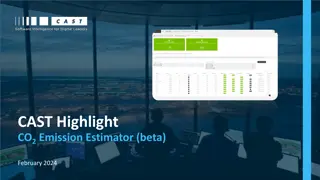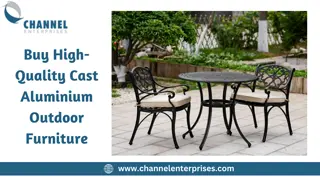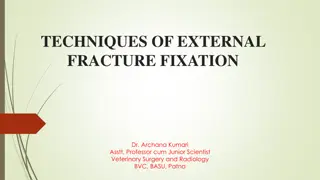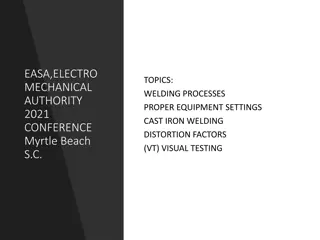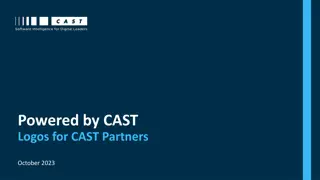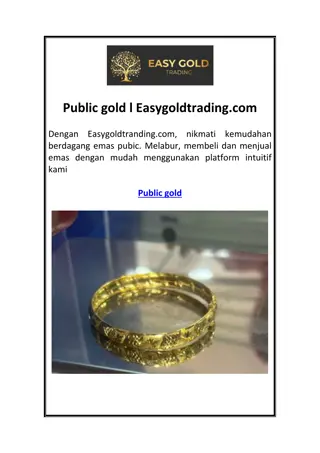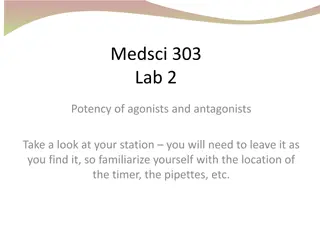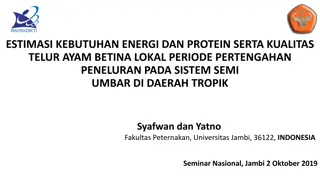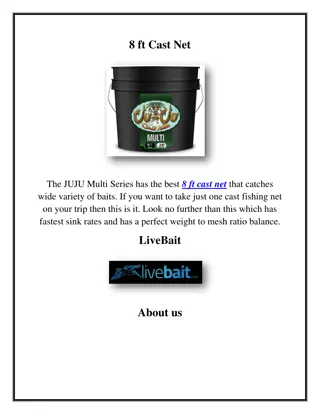
Casting Techniques and Comparison: Plaster vs. Fiberglass Casts
Discover the essential techniques for casting care and the differences between plaster and fiberglass casts. Learn about proper immobilization, preventing complications, and the advantages of each type of cast material. Get insights into cast padding, stockinette application, and key considerations for a successful casting process.
Download Presentation

Please find below an Image/Link to download the presentation.
The content on the website is provided AS IS for your information and personal use only. It may not be sold, licensed, or shared on other websites without obtaining consent from the author. If you encounter any issues during the download, it is possible that the publisher has removed the file from their server.
You are allowed to download the files provided on this website for personal or commercial use, subject to the condition that they are used lawfully. All files are the property of their respective owners.
The content on the website is provided AS IS for your information and personal use only. It may not be sold, licensed, or shared on other websites without obtaining consent from the author.
E N D
Presentation Transcript
Perawatan Pasien dengan Gips (Cast) Patient with a C a s t Home Home
Learning Outcomes 2. Menjelaskan perawatan yang diperlukan selama proses pengeringan gips 3. Mencegah komplikasi yang mungkin terjadi i. Pengkajian keperawatan untuk mendeteksi dini ii. Tindakan keperawatan untuk mengatasi kompliksasi 4. Pendidikan kesehatan bagi keluarga 1. Membandingkan dan menbedakan plaster & fiberglass casts (gips) Home Home
Casting Goal of semi-rigid immobilization while avoiding pressure / skin complications Often a poor choice in the treatment of acute fractures due to swelling and soft tissue complications Good cast technique necessary to achieve predictable results Home Home
Casting Techniques Stockinette - may require two different diameters to avoid overtight or loose material Caution not to lift leg by stockinette stretching the stockinette too tight around the heel may case high skin pressure Home Home
Casting Techniques To avoid wrinkles in the stockineete, cut along the concave surface and overlap to produce a smooth contour Figure from Chapman s Orthopaedic Surgery 3rd Ed. Home Home
Casting Techniques Cast padding Roll distal to proximal 50 % overlap 2 layers minimum Extra padding at fibular head, malleoli, patella, and olecranon Figure from Chapman s Orthopaedic Surgery 3rd Ed. Home Home
Plaster vs. Fiberglass Plaster Use cold water to maximize molding time Fiberglass More difficult to mold but more durable and resistant to breakdown Generally 2 - 3 times stronger for any given thickness Home Home
plaster casts fiberglass casts inexpensive has durability of plaster but is lighter weight heavy hardens within minutes sets in ~ 3 -1 5 minutes, then takes 24 - 72 h to dry (varies with thickness) is porous and there are fewer skin problems messy to apply does not soften when wet - hair dryer quickly dries skin beneath gives more support for bad breaks Costs more Home Home
Care required while the plaster cast dries once applied heat is given off for ~ 15 minutes & may be uncomfortable while the plaster sets, the cast will remain soft & touching may lead to indentations which may then create pressure spots until dry handle the cast with palms of hands only - not fingers do not rest cast on hard surfaces or sharp edges Home Home
note the use of 1. Stockinette 2. Padding 3. Casting material Home Home
Potential Complications hidden bleeding neurovascular compromise compartment syndrome skin &/or tissue breakdown hidden infection from wound &/or ulcer Home Home
Bleeding may occur beneath a cast if there is trauma to the skin at the time of injury surgery is required to reduce the fracture this will be documented as ORIF open reduction & internal fixation Home Home
To detect bleeding visualize the cast carefully. Give particular attention to areas over known wounds &/or incisions dependent areas - remember that liquid flow follows the line of gravity Home Home
Typical appearance (& terminology to describe) @ 1000 hours Sanguineous Sero-sanguineous @ 1200 hours serous @ 1400 hours Home Home
If you see bleeding Mark the outer edges of the bleeding area with time and date & then initial JW Example: Jan 10 - 1000 1200 1400 JW JW Then ---- > Home Home
Follow-up continue to monitor instruct client to call you if additional bleeding is noted &/or if s/he notices any other changes notify MD if bleeding continues there is a significant change in vital signs client condition changes Home Home
Document Narrative Notes 0845 dark red area ~ 3 cm diameter in narrative notes & indicate noted over outer aspect of malleolus; P 88, R 24, size BP 108/56; alert but pale; 0930 slight extension of bleeding; location client states feel fine vitals 1030 no further bleeding noted; P 80 BP 120/ 66 ; instructed to call other signs of nurse if further bleeding noted bleeding JWladyka RN Home Home
Neurovascular Compromise Compression of nerves and blood vessels may be caused by swelling 2 to injured tissue impinging bone pieces swelling 2 to surgery restrictive pressure 2 the cast Home Home
by doing C S M C colour plus capillary refill (normal < 3 sec) pulse in affected extremity [whether present -- no need to count] temperature of skin S sensation -- do not use a sharp object to assess M able to move extremity & digits Home Home
Frequency of C S M assess q2h X 8, then q4h X 48, then q 8 h at first sign elevate limb > heart give analgesia if symptoms persist notify MD stat as compartment syndrome may be occurring Home Home
If swelling persists the physician will order the cast to be bivalved Note - Bivalving may be done by a physician an orthopedic technician a specially trained nurse Home Burrell et al; 1586 Home
Compartment Syndrome - a special form of neurovascular compromise muscles, nerves & blood vessels are enclosed in though inelastic fascia (or compartments) if the muscle within a compartment becomes swollen it cannot stretch & thus the nerves and blood vessels are compressed Home Home
Signs & Symptoms deep, throbbing, unrelenting pain not controlled by analgesics often seems out of proportion to the injury swollen and hard muscle diminished capillary refill, cyanotic nailbeds, obscured pulse parasthesia, paralysis Home Home
To reverse compartment syndrome A fasciotomy is performed Burrell et al; 1590 Home Home
Skin &/or tissue breakdown Is most likely if the cast is resting too close to the tissue -- particularly over boney prominences cast edges are sharp and irritating the skin Home Home
Monitor Pressure Areas The cast over the area may become warm d/t inflammation beneath if there is skin breakdown there might be drainage if the area becomes infected there may be an odour Diagram to be added Home Home
Windowing a cast Using cast cutting equipment an orthopedic tech MD, or specially trained nurse cuts out a piece of the plaster over the area of concern if required a dressing is applied Picture to be added Home Home
Finishing a cast If the edges are not covered with stockinette, then you may need to cut small pieces of tape to smooth over the edges -- this is referred to petalling the cast Burrell et al; 1591 Home Home
Prosedur Pemasangan Gips Persiapan alat alat: Bahan gips dengan ukuran sesuai ekstremitas tubuh yang akan di gips Baskom berisi air hangat Gunting perban Bengkok Perlak dan alasnya Waslap/duk Pemotong gips Kasa dalam tempatnya Alat cukur Sabun dalam tempatnya Handuk Krim kulit Spons rubs ( terbuat dari bahan yang menyerap keringat) Padding (pembalut terbuat dari bahan kapas sintetis) Home Home
Prosedur Tindakan Siapkan klien dan jelaskan prosedur Siapkan alat-alat Daerah yang akan di pasang gips dicukur, dibersihkan,dan di cuci dengan sabun, kemudian dikeringkan dengan handuk Sokong ekstremitas atau bagian tubuh yang akan di gips. Posisikan dan pertahankan bagian yang akan di gips dalam posisi yang di tentukan Pasang duk pada klien. Pasang spongs rubs ( Balutkan gulungan bantalan tanpa rajutan dengan rata dan halus sepanjang bagian yang di gips. Tambahkan bantalan didaerah tonjolan tulang dan pada jalur saraf (mis: caput fibula) 1. 2. 3. 4. 5. 6. 7. 8. Home Home
Prosedur Tindakan Siapkan klien dan jelaskan prosedur Balutkan gulungan bantalan tanpa rajutan dengan rata dan halus sepanjang bagian yang di gips. Tambahkan bantalan didaerah tonjolan tulang dan pada jalur saraf (mis: caput fibula) Pasang gips secara merata pada bagian tubuh. Setelah pemasangan, haluskan tepinya, potong serta bentuk dengan pemotong gips. Bersihkan Partikel bahan gips dari kulit yang terpasang gips. Sokong gips selama pergeseran dan pengeringan dengan telapak tangan. Mendokumentasikan prosedur dan respons klien pada catatan klien 9. 10. 11. 12. 13. 14. 15. Home Home
Open surgical approach Direct Reduction Technique Home Home
Open reduction & internal fixation (ORIF) Plating through modified incisions Indirect reduction techniques Limited incision for: Passing and positioning the plate Individual screw placement Soft tissue friendly Home Home
External Fixation Temporary stabilization of long bone injuries in unstable patient Minimally invasive Decreases bleeding Pain control Nursing care Damage control Home Home
Traction Method of choice for acetabular and proximal femur fractures If there is a knee ligament injury usually use distal femur instead of proximal tibial traction Home Home
Traction Home Home

